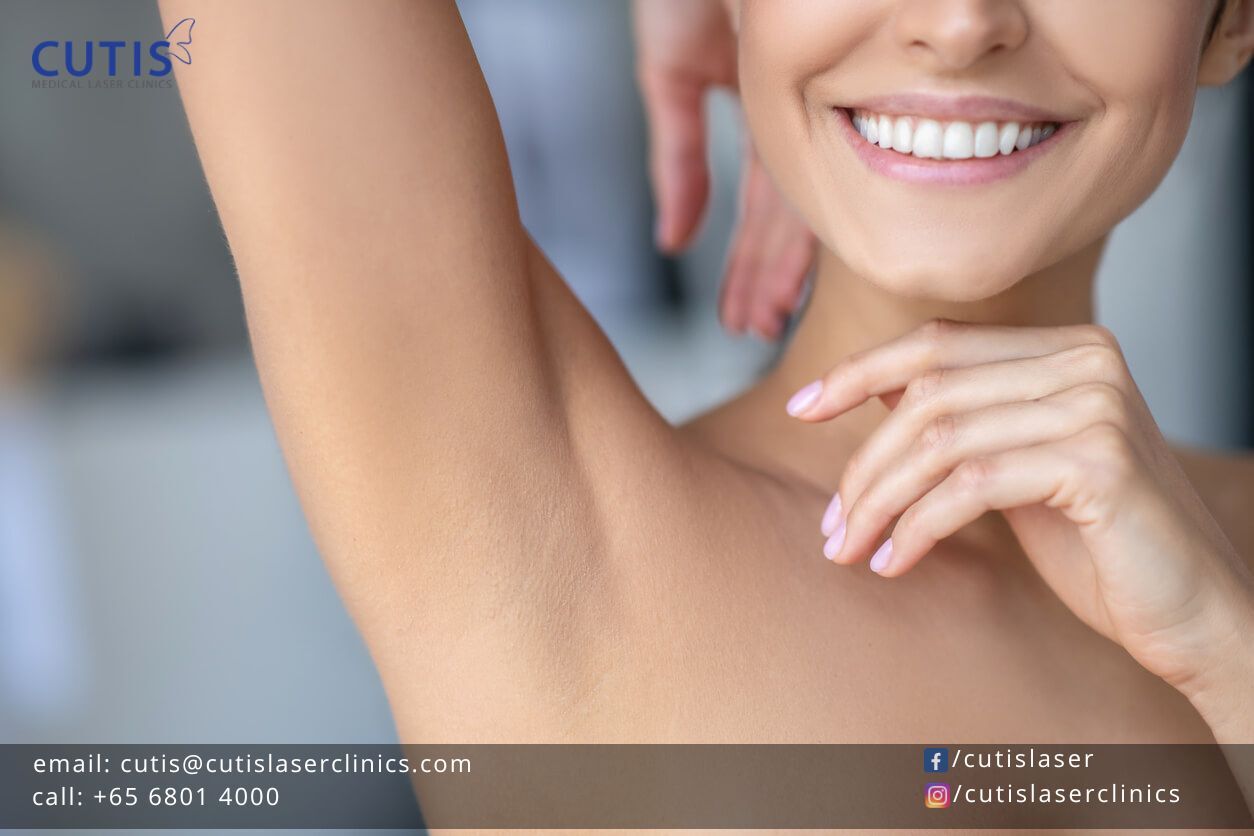Discoloration or hyperpigmentation in the underarms doesn’t just hold you back from wearing sleeveless shirts, swimsuits, or any clothing you want. It can sometimes be a source of embarrassment, negatively affect your self-esteem, and keep you from participating in certain activities such as sports.

So, what causes dark underarms?
It is actually normal for the skin on the underarms to be darker than the rest of the body. This is due to the constant friction it is subjected to, which can then lead to discoloration or pigmentation. It can include friction from your clothes, moving your arms, hair removal, and the buildup of dead skin cells.
Other things that can contribute to underarm darkening include:
- Shaving
- Certain deodorants and antiperspirants
- Certain medications
- Lack of exfoliation
- Increased melanin or hyperpigmentation
- Hormonal imbalance or disorders
- Acanthosis Nigricans or AN (a pigmentation disorder characterized by darkened skin in the neck, armpits, and groins)
Dos and don’ts of whitening dark underarms
While the discoloration in the area is not usually a serious health concern, many people dislike it or are frustrated by it. Mostly for cosmetic reasons, people wish to lighten their underarms, mainly by using whitening products such as soaps, scrubs, and deodorants. Some also use creams, gels, ointments, and natural remedies.
If you too are looking to whiten your underarm, it is important not to add any unnecessary friction that can lead to further discoloration. Identifying and treating the underlying cause is also important, as well as knowing the dos and don’ts of underarm whitening.
DOS
Rethink your hair removal method – If you remove your armpit hair by shaving, know that it causes abrasion and irritation, which can then lead to pigmentation. It is also believed that constant shaving contributes to the stimulation or extra production of melanocytes or pigment-producing cells.
Waxing can cause darkening too, especially if it is done the wrong way. Laser hair removal is a good option, as it targets the pigment in the hair and not the skin itself. At Cutis, we have several laser hair removal devices that use light and heat energy to target and destroy hair follicles and disable future hair growth. They also help with permanent hair reduction.
Switch to a gentle deodorant – Some deodorants and antiperspirants contain chemicals that can cause dryness and irritation. There are also cases where the mixture of bacteria and minerals (salt) in your armpits and the active ingredients in your deodorant can lead to discoloration.
Switch to a gentle or whitening deodorant that can help fight sweat and odor, as well as lighten discoloration. Choose a product with aloe vera, niacinamide, whitening extracts, and other soothing and moisturizing ingredients. Avoid those with irritating ingredients such as alcohol and synthetic fragrances.
Consider an aesthetic treatment – If OTC remedies produce a little effect or you want something that delivers noticeable results, aesthetic whitening treatments are worth considering. At Cutis, we have the Pink Intimate System, which is a painless skin lightening system specifically formulated for delicate areas.
This non-invasive topical solution, which is CE-marked and HSA Singapore-registered, contains a delicate mixture of safe lightening ingredients. It can lighten discoloration and unsightly blemishes in the underarms, inner thighs, areola, and intimate areas. You can see improvements after the first session, but the recommended protocol is six sessions, scheduled seven to 10 days apart.
Check out our previous post to learn more about the Pink Intimate System.
DON’TS
Whiten damaged or broken skin – Applying whitening products on skin with rashes, redness, or itching can only exacerbate the problem and lead to further irritation and darkening. The same is also true if you have sensitive skin and use a product with active or irritating ingredients to whiten your armpits.
If you have rashes or skin irritation with itching, flaking, or redness, see your physician before whitening the area. You’ll need to address those symptoms first to avoid further skin issues. It is also best to switch to gentle or hypoallergenic skincare products, especially if you have sensitive skin.
Scrub or rub your skin – While exfoliation can help prevent ingrown hairs and discoloration, overdoing it backfires. As added and unnecessary friction can lead to darkening, scrubbing your skin or rubbing it in an attempt to scrape off the discoloration can lead to irritation and thickening of the skin.
So, when exfoliating your armpits, avoid abrasives such as raw sugar or products with sharp-edged particles. Choose those that contain glycolic acid, lactic acid, and salicylic acid, as they can help slough off dead skin cells and promote renewal. You also need to remove or wipe off your deodorant each night or wear loose-fitting clothing if you’re a heavy sweater.
Further reading: Can You Build Stronger Skin?
Rely on DIY brightening or natural remedies – Although certain natural remedies can help reduce discoloration in the area, there is little research and evidence that they actually work. Common ingredients used for lightening dark skin include lemon juice, turmeric, baking soda, coconut oil, and others.
Certain home remedies can sometimes help, but do know that they may cause side effects. Lemon, for instance, is acidic and can lead to itching and irritation. Further irritation can cause the skin on your underarm to darken or thicken. It is advisable to see a skin or aesthetic doctor for safe and effective skin lightening methods.
Book a consultation
If dark underarms are making you self-conscious or are affecting your self-esteem, there are ways to reduce discoloration or lighten your skin. Sometimes, it can be as simple as stopping shaving or exfoliation, but there are cases where whitening products or aesthetic treatments are needed.
Contact Cutis Medical Laser Clinics in Singapore and book a consultation with our aesthetic doctor to find out how we can help you with your skin and body concerns.
- If you would like to be an informed patient, please contact us at +65-6801-4000 or
cutis@cutislaserclinics.com. - Cutis Medical Laser Clinics, 9 Scotts Road Pacific Plaza, Scotts Medical Center #08-07, Singapore – 228210
+65-6801-4000 - cutis@cutislaserclinics.com
